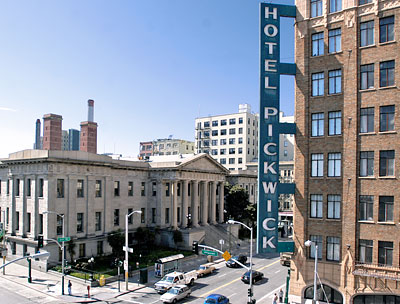San Francisco Landmarks
Old United States Mint
88 5th Street at Mission Street
Built 1874
As one consequence of the 1849 Gold Rush and the admittance, a year later, of California to the Union as the thirty-first state, San Francisco was selected by the United States Congress in 1852 to be the site of a branch mint. A mint established on Commercial Street in 1854 was rapidly outgrown.
By 1869, the Treasury Department had acquired a new site at Fifth and Mission Streets and had designed a monumental, Classical Revival building which combined the austerity of the popular Greek Revival style with the dignity of the Tuscan Doric order and the majesty of Roman scale and proportions.
Sandstone from Newcastle Island in British Columbia was shipped in by three schooners for the facing of the upper floors and for the six colossal columns on the portico. Rocklin granite provided the material for the basement walls. On May 26, 1870, the cornerstone was laid.
At a cost of approximately $2,000,000, the Old Mint was completed and occupied in 1874, commencing operations that continued until 1937 when the third mint to be constructed in San Francisco was erected further to the west on Market Street.
From San Francisco Planning Commission Resolution 16512 adopted on 16 January 2003.

In addition to being designated a National Historic Landmark in 1961 and a San Francisco Landmark in 2003, the Old United States Mint was also designated California Historical Landmark 875.
